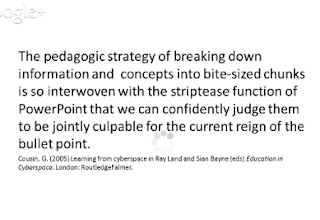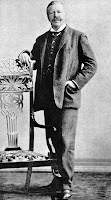As a first-time participant in an asynchronous online course, I got a better understanding of how my
Technology in Distance Education & E-learning course is organized when I re-read Terry Anderson and J. Dron's 2011 article,
Three Generations of Distance Education Technology." On my initial reading of the article, I focused on the first part-- a discussion of the evolution of Distance Education delivery technologies. But the article's second half talks about theories of learning, and how they relate to the technology being used to present the course.
They explain that cognitive-behaviourist teaching models came about in the "pre-Web, one-to-one, and one-to-many modes; social–constructivism flourished in a Web 1.0, many-to-many technological context; and connectivism is at least partially a product of a networked, Web 2.0 world."
"CB [Cognitive-Behaviorist learning] models provide a strong structure to learning that
makes explicit the path to be taken to knowledge. When done well, a cognitivist or behaviourist approach helps the learner to take a guided path towards a specific goal," they say.
"Constructivist models still place an emphasis on scaffolding, albeit in a manner that is more conducive to meeting individual needs and contexts." Connectivism, however, is kind of like being interested in a topic, gathering information about it and placing the results of your research on the web. But, as Anderson and Dron so reassuringly state, "Learning in connectivist space is, paradoxically, plagued by a lack of connection." This is reassuring because the lack of connection is exactly what I was feeling in this class.
The discussion of the connectivist learning model helped to show me that my reactions to the presentation of my class were possibly to be expected. Anderson and Dron say that because: "Connectivist learning happens best in network contexts, as opposed to individual or group
contexts...the first task of connectivist education involves exposing students to networks and providing opportunities for them to gain a sense of self-efficacy in networked-based cognitive skills and the process of developing their own net presence." In other words, the overwhelmingness of the opportunities for learning presented in the course is intentional. I am meant to begin by honing in on what knowledge I need and begin thinking about how to pursue it. Talk about learning how to learn!
This also begins to explain why the faculty presence in this course seems so limited-- it might be part of the courses' approach to encourage students to develop relationships with other course members to get their questions answered. As Anderson and Dron explain: "distance education interaction moves beyond individual consultations with faculty (CB pedagogy) and beyond the group interactions and constraints of the learning management systems associated with constructivist distance-education pedagogy. Cognitive presence is enriched by peripheral and emergent interactions on networks."
I like the way that this allows (forces!) students to take a good deal of responsibility for defining their own learning vector:
"In network contexts, members participate as they define real learning needs, filter these for relevance,
and contribute in order to hone their knowledge creation and retrieval skills. In the process, they develop networks of their own and increase their developing social capital (Davies, 2003; Phillips, 2002). " I also like that in the connectivist approach, the products of the learning process (aka "artifacts") become part of an online dialog that can go on well after the class is over: blogs and wiki definitions, for example, as well as making student's research papers available to others.
Just to be clear, though, this illumination did not happen without pain.
For the first 2-3 weeks of this course, every time I would access the WebTycho learning management system, I would literally have a panic attack. I experienced physical coldness, a sense of overwhelm, and the strong desire to give up. It seemed like each task that I set out to do would lead to other tasks. Not necessarily content-related tasks, but interface-related tasks. There were tutorials to watch, passwords to get, the necessity to understand the rhythm of the course (while the course began on a Monday, modules were segmented to end on Thursdays). All these feelings happened even though I was not under severe deadline pressure, and even though I consider myself to be technically savvy and comfortable with computers in general. I think it reminded me of being in 7th grade at a "school without walls" back in the 1970's- I did not know where I was supposed to be or what I was supposed to be doing for any particular class.
Despite these challenges, I am happy to report that, thanks to the availability and encouragement of the courses' writing coach, I cleared the hurdle of turning in my first writing assignment, and subsequently started to feel more in control of my learning environment. There is more class to go, more assignments and more discussion board topics, but I feel that I have a better understanding of what is expected.
I understand that there is always going to be a learning curve when first attempting to do something new-- like navigate an online LMS and a "distributed" learning environment. But I think it might be possible to provide more connection and encouragement for the student who is just beginning to undertake this kind of course work. I'd be interested in researching ways to do that.






